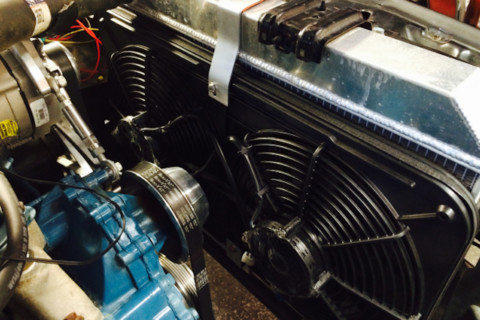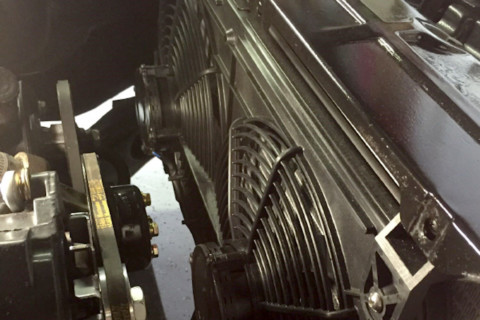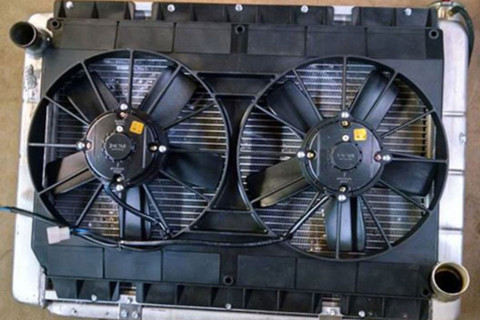Picking out a cooling fan is not simply a matter of choosing between an electric or engine-driven fan. For many of us, there is no replacement for displacement, so we are comfortable shoehorning big engines into small spaces. Space is always an issue. If you drive in heavy traffic, as we experience in Southern California, cars slow down or come to a stop on the freeway. Engine coolant flow remains the same but airflow slows down if using mechanical fans. Overheating becomes a reality. Electric cooling fans cover both of these concerns easily.
Once you have determined an electric fan is right for your car, you are faced with other choices. Do you go straight or do you pick a curved fan blade style? Pusher or puller type? Single or double fan setup? Believe it or not, there is a method behind the choices. To find out the hows and whys, we went to Maradyne High Performance Fans for answers. Maradyne fans are known for their lightweight and reinforced construction with the ability to move a lot of air when needed.
Why Go With Electric Cooling Fans?
The debate between mechanical fans and electric cooling fans has been discussed and settled years ago for most project car builders. But it is worth covering the basics so we are all starting from the same foundation. Almost every vintage muscle car came from the factory with belt-driven fans powered by engine RPM. Those fans take up a lot of space, provide parasitic engine horsepower draw, decrease the life of the water pump, and could accidentally hit the radiator or shroud in some vehicles.
If that wasn’t enough, belt-driven fans do not provide a lot of airflow at idle. The lower the engine RPM, the slower the fan, resulting in less airflow. Ideally, the goal of a cooling fan is to consistently manage the airflow through the radiator core to maintain about a 40-degree temperature drop from radiator inlet to outlet. “Managing and maintaining airflow is as critical at low speed or at engine idle as it is at higher speeds. Maradyne electric cooling fans deal with this situation precisely and efficiently,” said Maradyne’s Dan Whitten.
Cars from the 1950s and 1960s usually have plenty of room between the water pump and radiator core for a mechanical fan. Later model hot rods with huge engines transplanted in smaller frames typically have clearance problems. Electrical fans are a great solution. Many of these low-profile electric fan and shroud units fit with room to spare, move more air, and run quieter.
Pusher Or Puller Fan?
With many different electric fan options, it can be challenging when selecting the right one for a specific application. One of the easiest decisions is determining if you need a pusher or puller-type fan. A pusher fan mounts on the front of the radiator to push air through the radiator core toward the engine. It is easy to understand why this is referred to as a pusher-type fan and on the surface, it sounds like a decent option.
However, the fan, mounts, and fan motor all serve to block the air being rammed into the front of the car by forward motion. This is why most experts recommend using a puller fan whenever there is enough room between the radiator core and the front of the engine.
A puller fan sits right behind the radiator and pulls the air through the core with much less impact on airflow at higher speeds than a pusher-type fan. A puller fan used with a shroud that directs and focuses airflow provides more cooling capacity than a pusher fan. If under hood space doesn’t allow room for a puller fan, a pusher-type cooling fan can get the job done – just not with the same effect or efficiency.
Straight Or Curved Blades?
This is a far more complicated choice than just picking a style of fan blade. Closely related to the type of fan blade is the diameter of the fan and the fan/motor combination. All these factors are important in fan selection. Let’s dissect each of these facets to help explain how they figure into a wise cooling fan choice.
Years ago, there was the incorrect opinion that straight blades were stronger and more efficient than curved fan blades. Most modern electric fan blade designs are similar to Maradyne’s curved blade fans. These are built to be lightweight but are reinforced for strength and are quieter to operate due to the sweep of the leading edge of the blade. This helps with an aggressive angle of attack on the airflow, providing stronger, but quieter air movement.
In addition, Maradyne curved blade fans incorporate a concentric ring on the outside edge of the fan blades that hold the blades at the proper angle while adding even more strength. Air pressure flowing over the blades naturally tries to flatten the blades out to equalize the pressure on both the high- and low-pressure sides of the blades. The concentric ring prevents the blades from twisting and acting as a neutral airfoil at higher RPM, providing better, more consistent air movement.
“Keeping blade tip clearance to a minimum is important,” explained Maradyne’s product manager Jim Kahl. “The tighter the gap, the less air that can make it around the end of the blades. Air escaping around the ends of the blades reduces efficiency. Maradyne fans, with concentric rings, do an exceptional job at creating a very tight gap and improving fan performance and efficiency.”
Surface Area And Amperage
The shortest distance between two points is a straight line. Think of a straight fan blade having point A at the root of the blade, and point B at the tip of the fan. That gives you an idea of the surface area of a straight fan blade. A curved fan blade has several points along the leading edge of the blade and therefore has more surface area. With the proper angle of the blade and the right electric motor, the curved blade fan can provide more air movement across a larger surface area.
“Amperage has a lot to do with how efficient a fan works. Wind tunnel testing and airflow computational models show that curved blade designs require less current draw than straight fan blade designs,” said Kahl. In a scientifically designed curved blade fan, the leading edge of one blade starts working as the root of the blade before it finishes. This advanced curved blade design allows each blade to cut through the air with less effort reducing noise and energy.
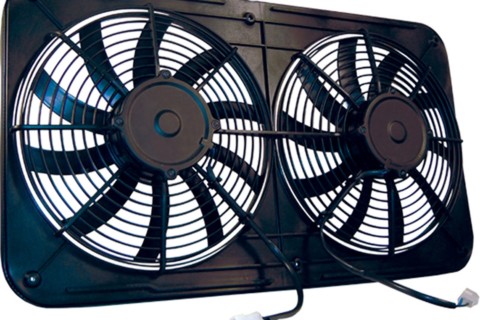
While a single fan may work for many applications, a dual-fan unit may be desirable for higher performance cars.
Fan Diameter
Speaking of surface area, another major factor when selecting an electric fan is the diameter of the fan. “When choosing a fan setup, ideally, you want one that covers as much of the radiator’s core as possible,” Whitten instructed. “Maradyne offers single and dual electric fan units that cover practically any automotive cooling situation.” Many street enthusiasts will find a single fan unit will provide more than enough cooling for their application. However…if you believe bigger is better when it comes to engine size and horsepower, a dual-fan combination might be a better choice.
Air management is far more complex than picking one fan or two, straight or curved blades, and the diameter – although size does matter – shrouding and vehicle design also play a critical role. Here’s why: Fans are circular and radiators are rectangular. Maximizing airflow and cooling effort over the entire radiator core is the goal.
Shrouds
Universally, we’ve been told over and over, no matter what type of cooling fan you select, use a shroud. No fan can efficiently direct airflow without a shroud and are all less effective without them in high-performance applications. Manufacturer design also comes into play when the vehicle has its radiator further back from the grille opening and ram air is directed to the front of the radiator. Cooler air from outside of the vehicle does a better job of lowering temperature than warmer underhood air.
Modern electric cooling fans usually come with some form of a shroud as a part of its construction. High-performance enthusiasts generally mount these fans to an even more elaborate shroud that covers more of the radiator core. Electric fans that attach directly to the core tend to only cool the circular section where the fan is mounted, in these cases, cooling potential is lost over the rest of the core. If you are mounting a 16-inch fan to the core, it cools a 16-inch circular section of that core. This same fan, used in conjunction with a shroud will cool the entire radiator core, by pulling air through the entire core surface.
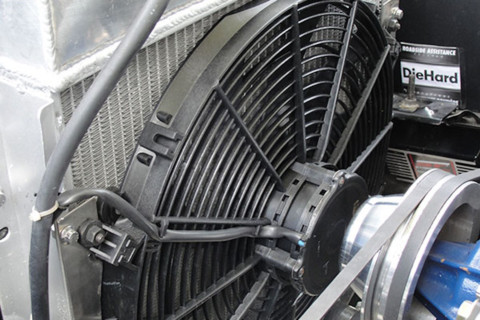
When in doubt, call the tech line at Maradyne for guidance concerning which fan for your application.
Summary
When it comes to cooling, electric cooling fans with curved blades and matched motors tend to move more air due to more surface area. Shrouds dramatically improve the efficiency of a fan’s ability to cool the radiator core. A puller fan tends to be more efficient than a pusher fan that is mounted to the front of a radiator. Finally, don’t forget to use relays, switches, and thermostats that allow the builder to set the engine temperature that the fans will operate within.
For more information or help in designing an efficient cooling system, visit Maradyne High Performance Fans at www.maradynehp.com.




